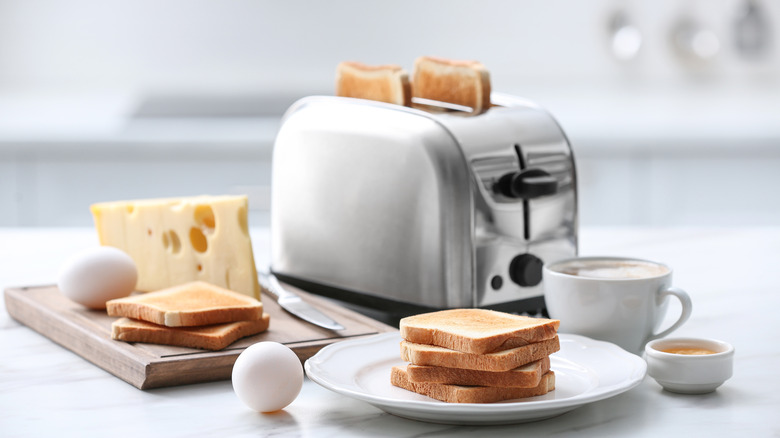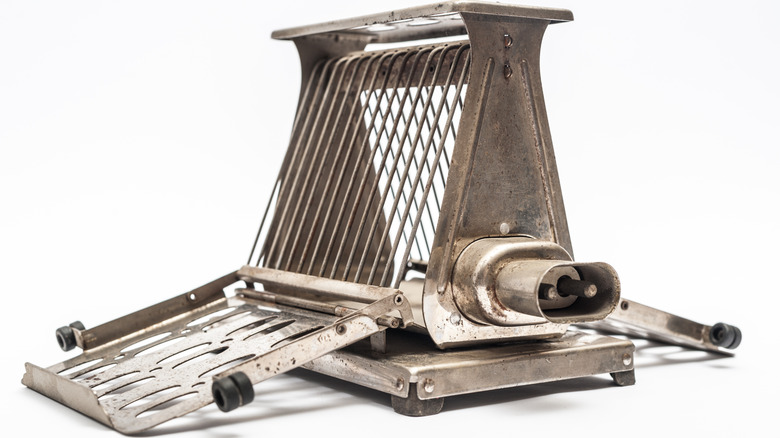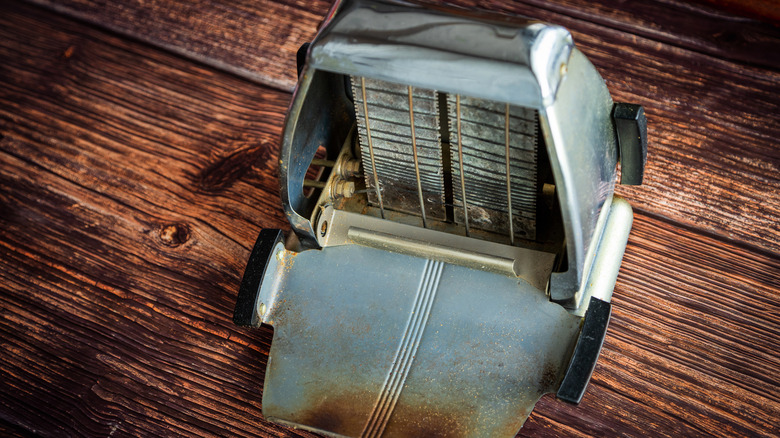Early Toasters Worked Way Differently Than They Do Today
The history of toast is unusual. It's generally agreed that people began browning bread over the fire as a way of preserving it from mold, making stale bread more edible, or making cedar plank grilled egg in toast. So far, so good: It couldn't have taken long for somebody to slather a slice with butter — but, no. Toast was usually thrown away after being used to warm drinks, leading to the phrase "the toast of the town." (In fact, "toast" became interchangeable with "hot," leading to this amazing proverb, immortalized in 1546: "Love had appeerd in hym to her alwase Hotte as a toste.") At some point, people got wise and began craving toast as a canvas for butter, jam, and a couple dozen other things, leading to an equally odd history of technological innovation, surplus hydroelectric power, and primitive wire-and-enamel electric appliances that looked more like torture devices.
Once human civilization got past the point of heating bread on warm rocks in front of the fire due to the invention of wood and coal stoves, somebody needed to invent the toaster. In the 1880s, a pyramidal wire-and-tin device was introduced, which basically held the bread slices in place over the stove until they toasted. (These contraptions are still around today, known as camping toasters.) You still had to negotiate around hot metal to find out if your toast had burned, but rest assured that new technology swiftly appeared, which didn't really solve the problem.
The Model D-12 Electric Hand Burner
As electric power became more widely available, inventors naturally seized upon the idea of using it to make toast. Enter Albert Marsh, who in 1906 invented a novel kind of filament composed of nickel and chromium, which he branded as Nichrome. This new wire had some very cool properties: it could get very hot when introduced to an electric current but also cool down quickly without burning out, allowing for repeated use. In other words, Albert Marsh invented the heating element. As a result, we got the first electric irons, percolators, and a Frankenstein's laboratory-looking contraption called the General Electric Model D-12 Electric Toaster.
Introduced in 1909, courtesy of its inventor Frank Shailor, the Model D-12 was made from four Nichrome-wound elements mounted on a ceramic base. Two slanted racks were mounted on either side of the elements, ensuring that only one side of the bread would get toasted. (Consumers could pay extra to have their toaster's plain white base adorned with a pastel floral decoration, which frankly only contributed to the thing's menacing-looking nature.) To top it off, the D-12's electrical cord had to be screwed into wall outlets wide enough for a toddler to basically fit their entire hand inside. Luckily, most private residences had yet to install electricity, so most of the early electric toasting was done in restaurants.
Surplus hydroelectric power and pop-up toasters
The story of the BC Electric Railway is suddenly relevant here. An English company that started life buying up Canadian street railways and small utility companies in the 1890s went full-on hydropower at the turn of the century. This was all well and good for the nighttime power demand of electric lights, but suddenly, the BCER had surplus daytime power and no one to pay for it. Its solution was to get the public to buy up all these newfangled electric irons, percolators, and toasters. Still, the march of technology had yet to take the solution of burned toast in its stride.
Enter Minneapolis inventor Charles P. Strite, who was tired of being served burnt toast in his manufacturing plant's cafeteria. In 1921, Strite was awarded a patent for his greatest invention, The Toastmaster, an electric toaster that could not only toast both sides of bread at the same time but also worked on a timer that operated an ejector spring. In other words, Strite invented the pop-up toaster. By 1926, Strite made the timer adjustable, allowing the user to choose their toast's desired brownness and perfecting a kitchen appliance that most of us use constantly and rarely think about (except when it is time to make pastrami toast with horseradish butter, natch).


